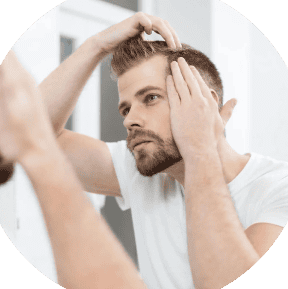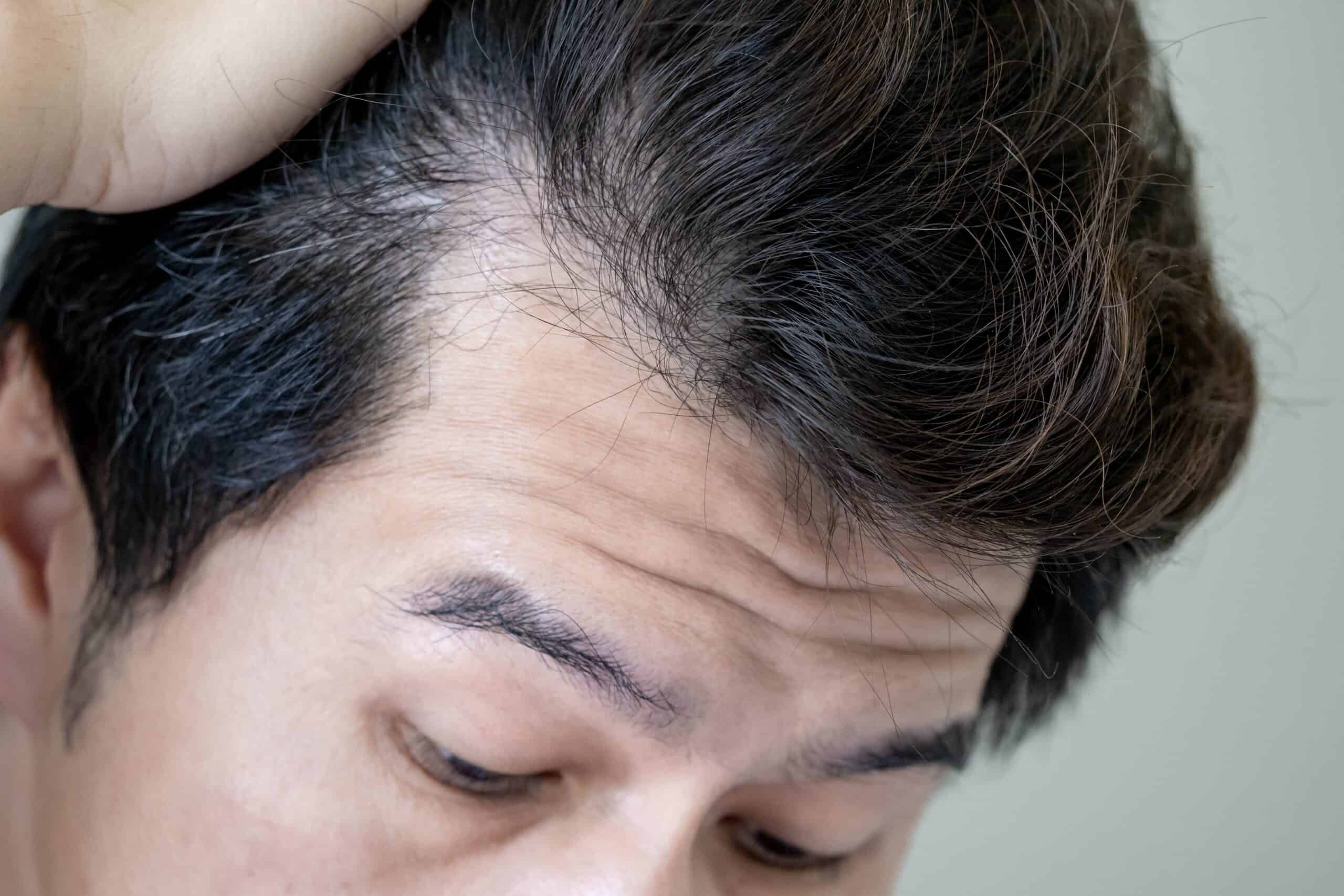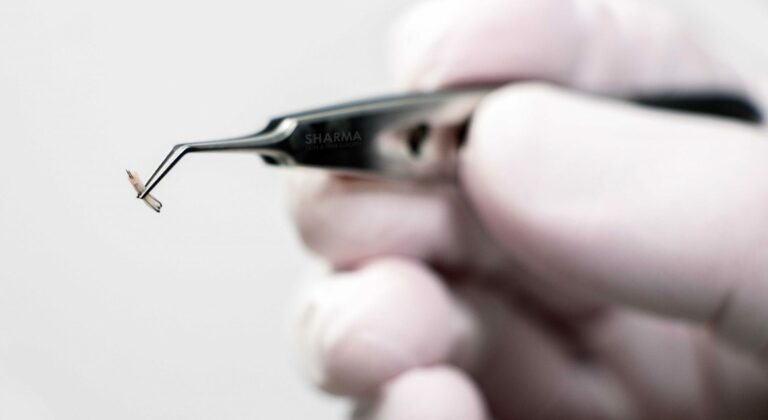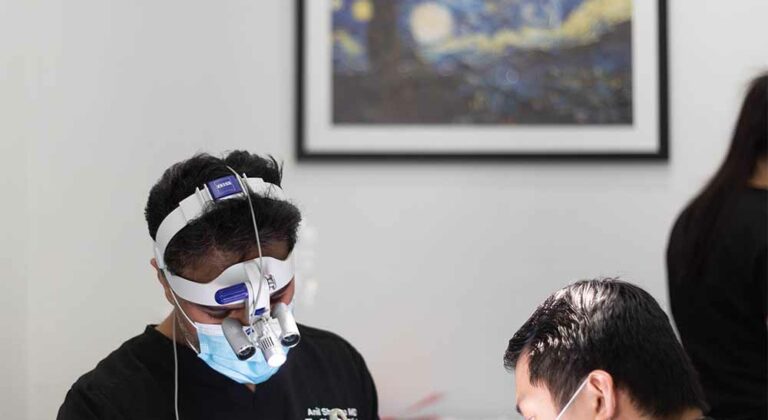It’s easy to confuse a maturing hairline with a receding hairline, but understanding the difference can make a big difference in how you approach your hair care. A maturing hairline is just a normal part of aging and doesn’t need any special treatment.
On the other hand, a receding hairline could be a sign of genetic hair loss, also known as “male pattern baldness,” which affects about 85% of men by the time they reach 50. The good news? While you don’t need to worry about treating a maturing hairline, there are effective treatments available for a receding hairline.
Recognizing which one you’re dealing with can help you decide on the best course of action. Keep reading to find out how to tell the two apart, how to assess your situation, and what treatment options are out there.
What is a mature hairline?
A mature hairline is a natural part of aging. Typically, men and women will see their hairline move back about 0.5-1 inch (1-2 cm) from its original position, known as the juvenile hairline. This process usually starts at the temples, creating a “widow’s peak” effect. It can take several years of slow but gradual progress to become noticeable, but most people start to see the change between the ages of 17 and 30.
What is a receding hairline?
A receding hairline tends to progress more quickly and usually begins earlier, often starting in your 20s or 30s. It typically recedes faster and deeper than a mature hairline, usually affecting the temples and/or the crown first, but it can spread to other areas over time.
Both receding and mature hairlines can cause uneven hair loss, with one side potentially thinning more than the other, especially in the early stages. However, mature hairlines generally present a more uniform appearance overall.
Discuss your hairline with Dr SharmaHow to tell if you have a receding or mature hairline
It can be tricky for the untrained eye to tell whether their hairline is moving back as part of a natural, mature hairline or due to a receding hairline. We always recommend visiting a hair restoration clinic for a more definitive answer. However, there are some tips you can follow at home to help you decide for yourself:
- Check for evenness: A maturing hairline typically moves back in a straight and even line. If you notice an “M” shape or unevenness — like one side receding more than the other — it might indicate a receding hairline. However, it’s not unusual for men to develop unevenness as they age. If your hairline moves back evenly, it’s likely just a maturing hairline.
- Measure the distance: If your hairline is between 1 and 1.5 inches (2-3 cm) above your highest forehead wrinkle, it’s probably a maturing hairline. It could be a sign of a receding hairline if it recedes beyond this point.
- Compare the shape: Use a removable marker pen to draw across your hairline. If the shape resembles an “M”, it might indicate a receding hairline. Conversely, if it looks more like a “V”, you’re likely looking at a widow’s peak, which is characteristic of a maturing hairline.
- Use the Norwood scale: The Norwood scale is a useful tool for gauging the stage of hair loss, with levels ranging from 1 to 7. If your hairline is gradually receding over many years, it’s likely just part of the natural aging process. But if you see quick changes through the Norwood stages, it might be a sign of male pattern baldness or another type of hair loss.
Treatments for a maturing hairline
Generally speaking, there’s no need to worry about a maturing hairline — it’s a normal part of getting older. But if it’s impacting your confidence, here are a few things you might consider:
Non-surgical treatments
If you’re unhappy with a maturing hairline and want to avoid surgery, you have some great non-surgical options to explore. Various medications and treatments could make a difference.
Finasteride
Finasteride is a daily pill that works by lowering DHT levels, which can slow hair loss for about 70% of users and help regrow hair in nearly 40% of cases.
While it’s generally effective, there are some rare but important side effects to consider, including the controversial post-finasteride syndrome (PFS). Although there’s no solid proof that PFS is a real issue, and it’s very rare if it is, it’s a good idea to be aware of the potential risks. It’s also worth noting that Finasteride isn’t suitable for women. If you’re interested, there’s also a topical version that might be even more effective for regrowing hair with fewer side effects.
Minoxidil
Minoxidil is another popular option, especially for the hairline. While most studies focus on the crown, many patients at the Sharma Clinic have had success using Minoxidil on their hairline as well. It comes in a topical solution, available as either a foam (which often works better) or a liquid. Men usually use a 5% solution, while women use a 2% solution. Rogaine is a well-known brand, but there are affordable generic versions like Hims that work just as well.
Steroid creams
Steroid creams can be effective for hair loss, especially when inflammation is involved, such as with Frontal Fibrosing Alopecia. These creams work by reducing inflammation on the scalp, which can help slow or stop hair loss.
Derma rolling
Derma rolling, or microneedling, involves using a roller with tiny needles to make small punctures in the scalp. This can boost hair growth by stimulating the hair follicles and improving the absorption of topical treatments like Minoxidil or Finasteride. It’s easy to do at home — just gently roll the device over your scalp in different directions. Make sure to follow good hygiene practices to avoid irritation or infection. It’s a useful way to boost the effectiveness of other treatments.
Find out more about Finasteride microneedlingRosemary oil
Rosemary oil might also be a helpful natural remedy for hair loss. Some early studies suggest it can improve blood flow to the scalp and reduce inflammation, which might encourage hair growth. Simply apply a few drops to the thinning areas and massage it in. It’s a simple and low-risk option that could be worth trying.
Lifestyle changes
Embracing a balanced lifestyle can make a big difference in your hair health. Regular exercise, like running or swimming, helps boost blood flow to your scalp, delivering essential nutrients and oxygen to your hair follicles. This can promote hair growth and keep your locks strong. Plus, exercise is a great way to manage stress, which can otherwise contribute to hair loss.
Getting 7-9 hours of quality sleep each night is also crucial. During sleep, your body works to repair and regenerate cells, including those in your scalp, which helps maintain healthy hair.
Eating a diet rich in fruits and vegetables gives your body the vitamins and minerals it needs to support hair health. Nutrients like vitamins A, C, D, E, zinc, and biotin are particularly important for keeping your hair strong and vibrant.
Medical procedures
If you’re thinking about taking the next step in treating a mature hairline, medical procedures might be worth considering. These options often deliver more noticeable and lasting results compared to non-surgical treatments. Here’s a look at some of the popular medical procedures for restoring your hair.
Platelet-Rich Plasma (PRP) Therapy
Platelet-Rich Plasma (PRP) Therapy is a popular treatment for thinning hair and hair loss. It starts with a small draw of your blood, which is then processed to concentrate the platelets — these are rich in growth factors. The concentrated PRP is then injected into the thinning areas of your scalp.
The process involves drawing your blood and spinning it in a centrifuge to separate out the platelets. Once prepared, the PRP is injected directly into the areas where you’re experiencing hair loss. Typically, you’ll need several sessions spread over a few months, with follow-up treatments every few months to maintain the results.
One major benefit of PRP therapy is that it uses your own blood, which reduces the risk of allergic reactions. The growth factors in the PRP can stimulate your hair follicles and boost hair density. Since it’s a non-surgical procedure, there are no cuts or stitches involved.
As for effectiveness, it varies from person to person. Some men notice a significant improvement in hair thickness and density, while others might see only minor changes. PRP therapy generally works best for those in the early stages of hair loss.
Low-Level Laser Therapy (LLLT)
If you’re looking to tackle a mature hairline, Low-Level Laser Therapy (LLLT) might be worth considering. This treatment uses low-level lasers or LEDs to stimulate your hair follicles and promote growth. The light helps boost blood flow, increase cell metabolism, and enhance collagen production in your scalp, which can lead to healthier hair.
Typically, LLLT involves using a device like a helmet, cap, or comb fitted with lasers or LEDs. Sessions usually last between 20 and 30 minutes, and you’ll need to use the device a few times a week.
There are various LLLT devices to choose from: handheld laser combs focus on smaller areas, while helmets or caps cover more of your scalp. Laser bands are headbands with built-in lasers designed for specific wear times.
Studies suggest LLLT can be effective for stimulating hair growth and improving density, particularly for those with androgenetic alopecia (pattern baldness). Consistency is important, and many men start seeing noticeable results after a few months of regular use.
Treatments for a receding hairline
If you’re facing a receding hairline and want to explore solutions, you have plenty of options. Whether you’re interested in non-surgical treatments or considering medical procedures, various approaches might fit what you’re looking for.
Non-surgical treatments
If you’re dealing with a receding hairline and prefer to avoid medical procedures or surgery, there are effective options. If you missed the earlier details, here’s a recap of some popular treatments for hair restoration:
- Finasteride: This daily pill lowers DHT levels and can slow hair loss for about 70% of users, with nearly 40% seeing some hair regrowth. While it’s generally effective, there are some rare but notable side effects, including the controversial post-finasteride syndrome (PFS).
- Minoxidil: Minoxidil comes as a topical foam or liquid. Men usually go with a 5% solution, and women use a 2% solution. Both Rogaine and affordable generics like Hims are effective.
- Steroid creams: These can help, especially with conditions like Frontal Fibrosing Alopecia where inflammation is a factor. They work by reducing inflammation on the scalp.
- Derma rolling: Using a roller with tiny needles on your scalp can boost hair growth by stimulating follicles and improving how well other treatments like Minoxidil or Finasteride are absorbed. Just be sure to keep things clean to avoid irritation or infection.
- Rosemary oil: This natural remedy might help by improving blood flow and reducing inflammation. Apply a few drops to thinning areas and gently massage it in.
- Lifestyle changes: A healthy lifestyle can make a big difference. Regular exercise, good sleep (7-9 hours a night), and a diet rich in fruits and vegetables all support hair health. Exercise boosts blood flow to your scalp, sleep aids in cell repair, and a balanced diet provides essential nutrients for strong hair.
Medical procedures
If you’re considering more effective treatments for a receding hairline, medical procedures could be worth exploring. Again, here’s a recap of the earlier details:
- Platelet-Rich Plasma (PRP) Therapy: PRP Therapy involves drawing your blood, concentrating the platelets, and injecting them into thinning areas on your scalp. It generally requires several sessions and ongoing maintenance. Since it uses your own blood, the risk of an allergic reaction is low.
- Low-Level Laser Therapy (LLLT): LLLT uses lasers or LEDs to stimulate hair follicles, enhancing blood flow and collagen production. Treatment typically involves a helmet, cap, or comb used for 20-30 minutes several times a week.
Surgical treatments
Now, if you’re looking at more advanced ways to tackle a receding hairline, medical procedures might be the next step. They often offer more noticeable and lasting results compared to non-surgical treatments. Let’s dive into some of the popular medical options for restoring your hair.
Hair transplant
Hair transplants are a top choice for dealing with hair loss, and while they’re more invasive than some other options, they’re generally well-tolerated. The procedure is typically done on an outpatient basis, meaning you can go home the same day. Full recovery usually takes about 2-3 weeks.
There are two main types of hair transplants: Follicular Unit Extraction (FUE) and Follicular Unit Transplantation (FUT). Both offer lasting results for hair loss.
- FUE: This method involves the surgeon making tiny cuts in the thinning areas of your scalp. They then extract individual hair follicles from the back and sides of your head and transplant them into the new areas.
- FUT: This technique involves removing a thin strip of skin from the donor area, from which hair follicles are taken and transplanted into the thinning spots. FUT can be very effective but may leave a thin scar on the back of your head.
Both FUE and FUT have a high success rate, with around 97-99% success when done right on suitable candidates.
Find our more about hair transplant surgeryScalp reduction surgery
Scalp reduction surgery is a surgical option for addressing bald or thinning areas on the scalp. During the procedure, the surgeon removes a portion of the bald skin and then pulls the remaining skin together, stitching it in place. This reduces the area that needs to be covered with hair.
The surgery is typically performed under local anesthesia, so you’ll be awake but won’t feel any pain during the process. The surgeon makes incisions to remove the bald areas, then tightens the scalp and stitches it closed. Sometimes, a tissue expander is used beforehand to stretch the skin, making the procedure easier.
After the surgery, you might experience some swelling, bruising, and discomfort, but these symptoms usually subside within a few weeks. Most people can resume their normal activities relatively quickly. Scalp reduction can be an effective solution for those looking to enhance their hair coverage.
Concerned about hair loss? Discover expert solutions at the Sharma Clinic
As you can see, distinguishing between a mature hairline and a receding hairline is crucial for addressing your hair care needs effectively. While a mature hairline is a natural and gradual part of aging, a receding hairline often signals genetic hair loss and may require targeted treatments.
If you’re concerned about your hairline and want to understand whether you’re experiencing a natural change or something more serious, the Sharma Clinic is here to help. Our team of specialists understands how important your hair is to you and can offer personalized advice and treatments to address your specific needs. Whether you’re dealing with a naturally maturing hairline or experiencing more significant hair loss, we’ve got the expertise to guide you.
BOOK NOW
Talk to a Hair Loss Expert
Are you looking for the most effective treatment plan to reverse the effects of hair loss? Dr. Sharma has a long-lasting commitment to offering the best services in the industry. Not only is he experienced with hair loss treatment, but he is passionate about helping each patient receive excellent results.

SOURCES
- https://plasticsurgerykey.com/phenotype-of-normal-hairline-maturation/
- https://my.clevelandclinic.org/health/diseases/23316-frontal-fibrosing-alopecia
- https://www.ncbi.nlm.nih.gov/books/NBK278957/
- https://pubmed.ncbi.nlm.nih.gov/10365924/
- https://pubmed.ncbi.nlm.nih.gov/9777765/
- https://www.ncbi.nlm.nih.gov/pmc/articles/PMC7649170/
- https://www.ncbi.nlm.nih.gov/pmc/articles/PMC4809380/
- https://www.ncbi.nlm.nih.gov/pmc/articles/PMC3746236/
- https://pubmed.ncbi.nlm.nih.gov/32033719/
- https://www.ncbi.nlm.nih.gov/pmc/articles/PMC10186041/
Share this:
Medically reviewed by
Updated on
Have a question?
Find out how we can help you look feel your absolute best
Contact us 780-476-7970


